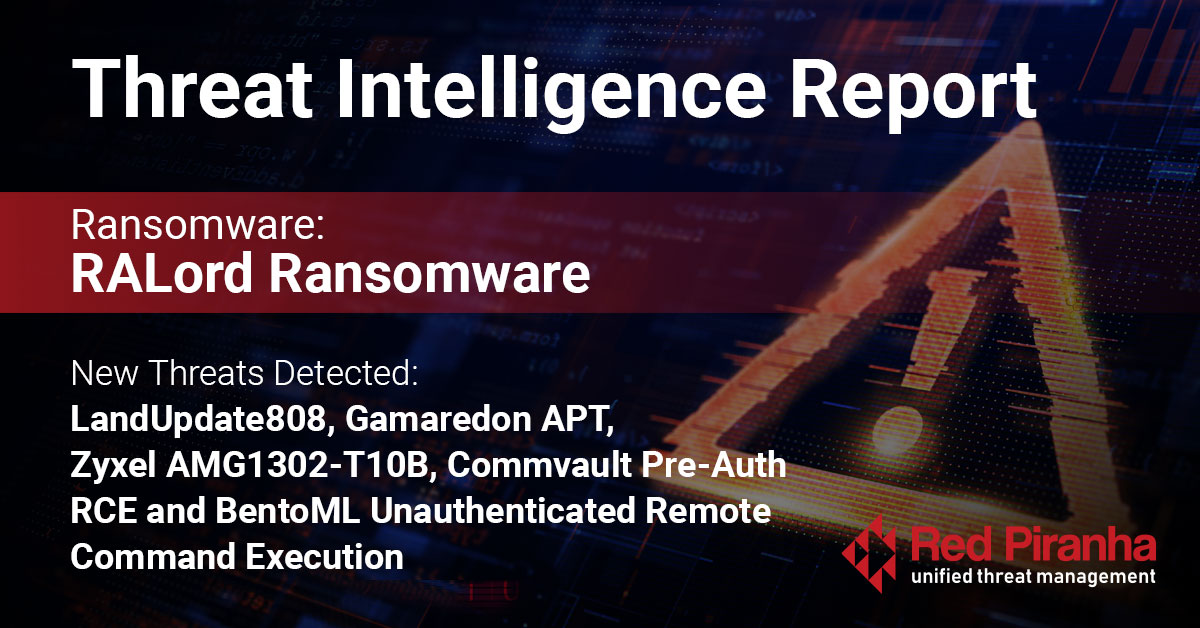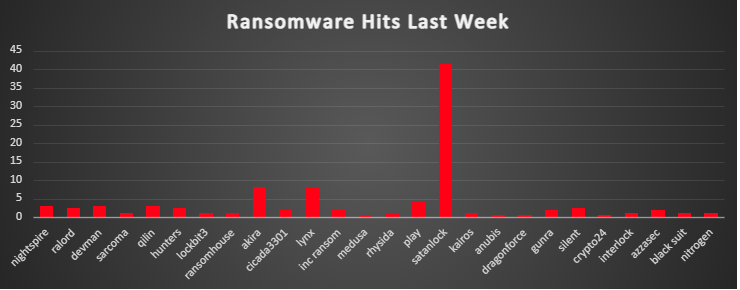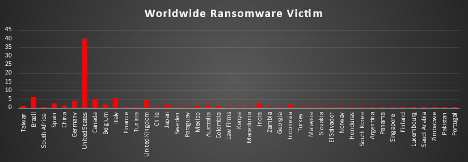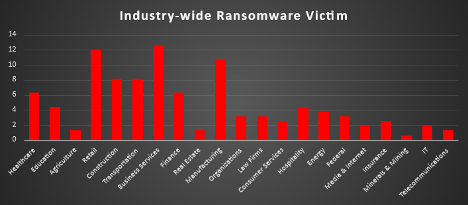
| New Threat Detection Added | 5 |
| • LandUpdate808 • Gamaredon APT • Zyxel AMG1302-T10B • Commvault Pre-Auth RCE • BentoML Unauthenticated Remote Command Execution | |
| New Threat Protections | 174 |
Weekly Detected Threats
The following threats were added to Crystal Eye this week:
Threat name: | LandUpdate808 | ||||||||||||||||||
LandUpdate808 is a malicious downloader campaign that delivers malware disguised as fake browser updates. Victims are lured through compromised websites that display deceptive upgrade notices (e.g., Chrome update prompts). Once clicked, a script or executable loader is dropped, further deploying remote access tools like NetSupport RAT. The campaign uses cookie tracking to avoid reinfection and aggressively rotates file types (JavaScript, EXE, MSIX) to evade detection. Its objective is to establish remote control on victim systems for further exploitation. | |||||||||||||||||||
Threat Protected: | 02 | ||||||||||||||||||
Rule Set Type: |
| ||||||||||||||||||
Class Type: | Exploit Kit | ||||||||||||||||||
Kill Chain: |
| ||||||||||||||||||
Threat name: | Gamaredon APT | |||||||||||||||||||||||||||||||||
Gamaredon (also known as Armageddon or Shuckworm) is a Russian-aligned APT group specialising in cyber-espionage against Ukrainian and governmental organisations. The group uses phishing emails with malicious attachments to implant lightweight but persistent backdoors such as Pterodo. Their tactics include heavy obfuscation, credential harvesting, lateral movement via infected USBs, and fast flux C2 domains. The primary goal is long-term surveillance and confidential data exfiltration. | ||||||||||||||||||||||||||||||||||
Threat Protected: | 15 | |||||||||||||||||||||||||||||||||
Rule Set Type: |
| |||||||||||||||||||||||||||||||||
Class Type: | Domain-c2 | |||||||||||||||||||||||||||||||||
Kill Chain: |
| |||||||||||||||||||||||||||||||||
Threat name: | Zyxel AMG1302-T10B Directory Traversal Attempt (CVE-2025-3577) | ||||||||||||||||||
A directory traversal vulnerability in Zyxel AMG1302-T10B router web interfaces allow authenticated administrators to access arbitrary files outside the web root. Exploiting this flaw can leak sensitive information such as system credentials, WLAN keys, and internal configuration files. While it requires an admin login to exploit, it drastically expands an attacker’s capabilities post-authentication. | |||||||||||||||||||
Threat Protected: | 01 | ||||||||||||||||||
Rule Set Type: |
| ||||||||||||||||||
Class Type: | Web-application-attack | ||||||||||||||||||
Kill Chain: |
| ||||||||||||||||||
Threat name: | Commvault Pre-Auth RCE (CVE-2025-34028) | |||||||||||||||||||||
A critical pre-authentication remote code execution vulnerability in the Commvault Command Center allows unauthenticated attackers to execute arbitrary code by uploading crafted ZIP archives. Exploitation can lead to full compromise of backup servers, exfiltration of sensitive data, or lateral movement within the network. Proof-of-concept exploits are already circulating, making unpatched systems extremely high risk. | ||||||||||||||||||||||
Threat Protected: | 02 | |||||||||||||||||||||
Rule Set Type: |
| |||||||||||||||||||||
Class Type: | Domain-c2 | |||||||||||||||||||||
Kill Chain: |
| |||||||||||||||||||||
Threat name: | BentoML Unauthenticated Remote Command Execution via Insecure Deserialisation | |||||||||||||||||||||
An insecure deserialisation vulnerability in BentoML’s model-serving platform allows remote unauthenticated code execution. By sending a specially crafted serialised object to exposed BentoML API endpoints, attackers can execute arbitrary Python code on the server. This attack can lead to a complete host takeover, manipulation of machine learning models, and pivoting to other internal systems. | ||||||||||||||||||||||
Threat Protected: | 02 | |||||||||||||||||||||
Rule Set Type: |
| |||||||||||||||||||||
Class Type: | Trojan-activity | |||||||||||||||||||||
Kill Chain: |
| |||||||||||||||||||||
Known Exploited Vulnerabilities (Week 4 - April 2025)
CISA (https://www.cisa.gov/known-exploited-vulnerabilities-catalog)
Vulnerability | CVSS | Description | |
CVE-2025-34028 | 10.0 (Critical) | Commvault Command Center Innovation Release contains a path traversal vulnerability that allows an unauthenticated remote attacker to upload a ZIP archive which upon extraction can result in Remote Code Execution. This vulnerability affects versions 11.38.0 through 11.38.19 and was fixed in versions 11.38.20 and 11.38.25, no other versions are affected. | |
CVE-2025-42599 | 9.8 (High) | Qualitia Active! Mail contains a stack-based buffer overflow vulnerability that can allow an unauthenticated remote attacker to send a specially crafted request that can allow for remote code execution or denial of service. This vulnerability affects versions 6.60.05008561 and earlier and is fixed in version 6.60.06008562. This vulnerability is currently under active exploitation. | |
CVE-2025-1976 | 8.6 (High) | Broadcom Brocade Fabric OS contains a code execution vulnerability that allows for an authenticated user with admin privileges to execute commands with full root privileges. This vulnerability affects the IP Address validation functionality of the Fabric OS, and although root access was removed in version 9.1.0, it can be exploited to execute existing Fabric OS commands and can also be used to modify the Fabric OS itself. This affects versions 9.1.0 through 9.1.1.d6 and is known to be actively exploited in the wild. This vulnerability was fixed in Faric OS version 9.1.1d7 and does not affect versions 9.2.0+, Brocade ASCG or Brocade SANnav. |
Updated Malware Signatures (Week 4 - April 2025)
Threat | Description | |
WordPress Social Warfare Plugin Exploit Related Domain | Attackers are exploiting vulnerabilities in outdated versions of the Social Warfare WordPress plugin to gain unauthorised access, execute code, or redirect site traffic. Domains associated with these exploits are often used to host malicious payloads or serve as C2 infrastructure for follow-on attacks. Targeted exploitation may lead to full site compromise or redirection to phishing/malware sites. | |
PhantomNet C2 Domain | PhantomNet is a stealthy command-and-control (C2) framework used by threat actors to manage compromised machines across global networks. PhantomNet-related domains are leveraged to deliver commands, exfiltrate stolen data, and deploy secondary payloads. Its infrastructure emphasises evasion through frequent domain changes and encrypted communications. | |
Arkei/Vidar/Mars Stealer Variant Data Exfiltration | Arkei, Vidar, and Mars Stealer are modular infostealers designed to harvest browser credentials, cryptocurrency wallets, and system data. Recent variants rapidly exfiltrate collected information to attacker-controlled servers shortly after infection. The malware prioritises stealth, using encrypted channels and compression techniques to minimise detection during data theft. |
| Ransomware Report | |
The Red Piranha Team conducts ongoing surveillance of the dark web and other channels to identify global organisations impacted by ransomware attacks. In the past week, our monitoring revealed multiple ransomware incidents across diverse threat groups, underscoring the persistent and widespread nature of these cyber risks. Presented below is a detailed breakdown of ransomware group activities during this period. | |
| Name of Ransomware Group | Overall %age of total attack coverage |
Nightspire | 3.14% |
RALord | 2.52% |
Devman | 3.14% |
Sarcoma | 1.26% |
3.14% | |
Hunters | 2.52% |
1.26% | |
RansomHouse | 1.26% |
Akira | 8.18% |
Cicada3301 | 1.89% |
Lynx | 8.18% |
Inc Ransom | 1.89% |
0.63% | |
1.26% | |
4.4% | |
Satanlock | 41.51% |
Kairos | 1.26% |
Anubis | 0.63% |
DragonForce | 0.63% |
Gunra | 1.89% |
Silent | 2.52% |
Crypto24 | 0.63% |
Interlock | 1.26% |
AzzaSec | 1.89% |
1.26% | |
Nitrogen | 1.26% |

RALord Ransomware Group
Description
RALord is an emerging ransomware threat group identified in 2025. Operating under the Nova RaaS (Ransomware-as-a-Service) model, the group provides affiliates with a ready-made payload and retains 15% of ransom proceeds. RALord's operations revolve around double-extortion tactics — encrypting data and threatening to publish stolen information on their Tor-based leak site. The group primarily uses two ransomware variants: one written in Rust (appending ".RALord") and the Nova-based variant (appending ".nova"). Victims are instructed to contact operators through encrypted messaging services like qTox and Session. Notably, RALord has claimed to exempt schools and non-profits, though it continues to target a wide range of sectors globally.
Detailed TTPs
- Exploits vulnerable public-facing applications (e.g., VPNs, firewalls, RDP)
- May use spear-phishing or stolen credentials
- Persistence achieved via Hijack Execution Flow (T1574)
- Affiliates use tools like Cobalt Strike for lateral movement
- Executed manually with administrative privileges
- Rust-based 64-bit payload invokes conhost.exe to run encryption logic
- Encrypts files with RC4 stream cipher
- Appends ".RALord" or ".nova" extensions
- Drops ransom note (README-.txt) in each folder
- No active C2 in binary
- Victims contact operators via:
- Tox ID: 0C8E5B45C57AE244E9C904C5BC74F73306937469D9CEA22541CA69AC162B8D42A20F4C0382AC
- Session ID: 054f55ec93aca9bac362b9d91eff36a7ce451e7caba47c0b2e004ba429f9529c79
- Encrypts and steals data for extortion
- Causes operational downtime, data breach risks, and reputational damage
TTP Chart
Tactic | Technique | ID | Description |
Initial Access | Exploit Public-Facing Application | T1190 | Exploits VPNs, firewalls, RDP |
Execution | Native API | T1106 | Runs conhost.exe and invokes encryption logic |
Persistence | Hijack Execution Flow | T1574 | Registry/DLL hijack for persistence |
Privilege Escalation | Hijack Execution Flow | T1574 | Used to elevate privileges |
Defence Evasion | Impair Defences | T1562 | Terminates AV, disables backups |
Discovery | Network Share Discovery | T1135 | Maps and encrypts shared folders |
Lateral Movement | Remote Services (PsExec, SMB) | T1021 | Manual propagation via admin tools |
Exfiltration | Exfiltration Over C2 Channels | T1041 | Data stolen pre-encryption via secure channels |
C2 | Application Layer Protocol | T1071.001 | Tor, Tox, Session for comms |
Impact | Data Encrypted for Impact | T1486 | Files encrypted using RC4 |
Impact | Inhibit System Recovery | T1490 | Deletes shadow copies, backup services |
IOCs
- .RALord
- .nova
- SHA-256: 456B9ADAABAE9F3DCE2207AA71410987F0A571CD8C11F2E7B41468501A863606
- MD5: be15f62d14d1cbe2aecce8396f4c6289
- README-.txt
- Tor Sites:
- ralord3htj7v2dkavss2hjzviviwgsf4anfdnihn5qcjl6eb5if3cuqd.onion
- ralordqe33mpufkpsr6zkdatktlu3t2uei4ught3sitxgtzfmqmbsuyd.onion
- ralordt7gywtkkkkq2suldao6mpibsb7cpjvdfezpzwgltyj2laiuuid.onion
- conhost.exe spawns on execution
- Suspicious registry Run entries
- Use of expand.exe during unpacking
Mitigation Strategies
- Apply patches to VPNs, RDP, and firewall appliances
- Implement MFA and strong access controls
- Segment networks and enforce the least privilege
- Deploy EDR and monitor for bulk file encryption patterns
- Backup data securely and keep backups offline
- Disable unnecessary services and script engines
- Train staff on phishing and ransomware awareness
- Monitor for use of Tox, Session, and Tor applications
- Search for ransom notes and encrypted file extensions as early detection indicators
Ransomware Victims Worldwide
A recent analysis of the global ransomware threat landscape highlights that the United States remains the most heavily impacted nation, accounting for a significant 39.62% of all reported ransomware incidents. This continued dominance underscores the country’s high-value target status among financially and politically motivated threat actors, driven by its vast digital infrastructure and critical industry base.
Brazil ranks second with 6.29% of incidents, reflecting growing ransomware activity in Latin America and signalling increased attention from cybercriminal groups toward emerging economies. Italy follows with 5.66%, while Canada reports 5.03%, and the United Kingdom comes close behind at 4.4%. These figures suggest a sustained threat presence in both Southern Europe and North America.
Germany experienced 3.77% of global attacks, indicating its continued exposure as a key player within the European industrial and technological landscape. Spain and India each accounted for 2.52%, highlighting a broader targeting of both Western and South Asian nations. Other countries with notable activity include Japan, Australia, Belgium, and Indonesia, each contributing 1.89% of global ransomware cases, reflecting a diversification in threat actor targeting strategies.
Several countries reported 1.26% of incidents each, including Taiwan, China, Mexico, and Colombia, suggesting that cybercriminals are actively expanding their focus to East Asian and Latin American regions. A wide range of countries reported 0.63% of global ransomware cases, including South Africa, Tunisia, Chile, Sweden, Paraguay, Kenya, Macedonia, Zambia, Georgia, Turkey, Malaysia, Slovakia, El Salvador, Norway, Honduras, South Korea, Argentina, Panama, Singapore, Finland, Luxembourg, Saudi Arabia, Zimbabwe, Pakistan, and Portugal. Though individually lower in volume, these instances underscore the global sprawl of ransomware operations.
This widespread and uneven distribution of ransomware activity reinforces the transnational and indiscriminate nature of cybercrime today. It calls for coordinated global defence strategies, including robust intelligence sharing, public-private sector cooperation, and investment in proactive cybersecurity infrastructure to mitigate the evolving ransomware threat across geopolitical and economic boundaries.

Ransomware Victims by Industry
In the most recent industry-specific analysis of ransomware activity, the Business Services sector has emerged as the most targeted, accounting for 12.58% of global incidents. This reflects the growing threat landscape for consulting, outsourcing, and professional service providers, who often serve as gateways to sensitive client data and broader supply chains.
The Retail sector follows closely, representing 11.95% of ransomware cases. The high volume of customer transactions, personal data, and seasonal sales cycles make retail organisations attractive to ransomware operators seeking maximum disruption. Manufacturing ranks third at 10.69%, emphasising the sector’s ongoing exposure due to its reliance on industrial control systems and tightly integrated production lines.
Both the Construction and Transportation sectors each reported 8.18% of incidents, indicating that infrastructure-heavy industries remain high-value targets. The operational disruption caused by ransomware in these sectors can have cascading effects across national supply chains and public utilities.
The Healthcare and Finance industries each accounted for 6.29% of cases. These sectors continue to draw attention due to the high-value data they handle—be it patient records or financial transactions—and their critical need for uptime. Meanwhile, the Education and Hospitality sectors, each with 4.4% of incidents, highlight the vulnerability of institutions catering to the public and managing vast stores of personally identifiable information.
Sectors such as Law Firms, Federal, Organisations, and Energy each faced 3.14%–3.77% of the attacks, showcasing how ransomware operators value legal, governmental, and utility-related data. Consumer Services and Insurance industries also reported meaningful levels of activity at 2.52% each, underscoring the continued diversification of targets.
At the lower end of the spectrum, Agriculture, Real Estate, and Telecommunications each accounted for 1.26%, while Media & Internet and IT stood at 1.89%. These figures demonstrate that no industry—regardless of size or public profile—is beyond the reach of ransomware campaigns.
Minerals & Mining reported 0.63%, but even such niche sectors are being probed by cybercriminals, highlighting the opportunistic nature of modern ransomware actors.
This industry-wide distribution emphasises the cross-sector impact of ransomware and the urgent need for tailored security strategies, cyber hygiene awareness, and sector-specific resilience plans. Whether dealing with digital infrastructure, client-facing operations, or national interests, every industry must treat ransomware as a critical operational risk in today’s interconnected threat environment.

